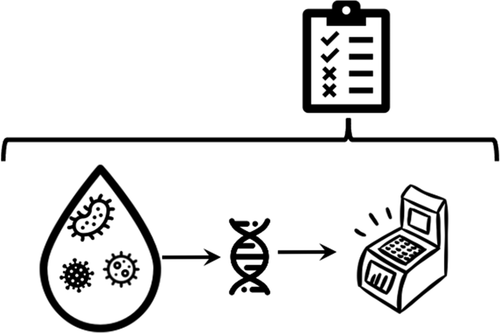当前位置:
X-MOL 学术
›
Environ. Sci. Technol.
›
论文详情
Our official English website, www.x-mol.net, welcomes your
feedback! (Note: you will need to create a separate account there.)
The Environmental Microbiology Minimum Information (EMMI) Guidelines: qPCR and dPCR Quality and Reporting for Environmental Microbiology
Environmental Science & Technology ( IF 10.8 ) Pub Date : 2021-07-21 , DOI: 10.1021/acs.est.1c01767 Mark A Borchardt 1 , Alexandria B Boehm 2 , Marc Salit 3, 4 , Susan K Spencer 1 , Krista R Wigginton 5 , Rachel T Noble 6
Environmental Science & Technology ( IF 10.8 ) Pub Date : 2021-07-21 , DOI: 10.1021/acs.est.1c01767 Mark A Borchardt 1 , Alexandria B Boehm 2 , Marc Salit 3, 4 , Susan K Spencer 1 , Krista R Wigginton 5 , Rachel T Noble 6
Affiliation

|
Real-time quantitative polymerase chain reaction (qPCR) and digital PCR (dPCR) methods have revolutionized environmental microbiology, yielding quantitative organism-specific data of nucleic acid targets in the environment. Such data are essential for characterizing interactions and processes of microbial communities, assessing microbial contaminants in the environment (water, air, fomites), and developing interventions (water treatment, surface disinfection, air purification) to curb infectious disease transmission. However, our review of recent qPCR and dPCR literature in our field of health-related environmental microbiology showed that many researchers are not reporting necessary and sufficient controls and methods, which would serve to strengthen their study results and conclusions. Here, we describe the application, utility, and interpretation of the suite of controls needed to make high quality qPCR and dPCR measurements of microorganisms in the environment. Our presentation is organized by the discrete steps and operations typical of this measurement process. We propose systematic terminology to minimize ambiguity and aid comparisons among studies. Example schemes for batching and combining controls for efficient work flow are demonstrated. We describe critical reporting elements for enhancing data credibility, and we provide an element checklist in the Supporting Information. Additionally, we present several key principles in metrology as context for laboratories to devise their own quality assurance and quality control reporting framework. Following the EMMI guidelines will improve comparability and reproducibility among qPCR and dPCR studies in environmental microbiology, better inform engineering and public health actions for preventing disease transmission through environmental pathways, and for the most pressing issues in the discipline, focus the weight of evidence in the direction toward solutions.
中文翻译:

环境微生物学最低信息 (EMMI) 指南:环境微生物学的 qPCR 和 dPCR 质量和报告
实时定量聚合酶链式反应 (qPCR) 和数字 PCR (dPCR) 方法彻底改变了环境微生物学,产生了环境中核酸目标的定量生物体特异性数据。这些数据对于描述微生物群落的相互作用和过程、评估环境中的微生物污染物(水、空气、污染物)以及制定干预措施(水处理、表面消毒、空气净化)以遏制传染病传播至关重要。然而,我们对健康相关环境微生物学领域最近的 qPCR 和 dPCR 文献的回顾表明,许多研究人员没有报告必要和充分的控制和方法,这将有助于加强他们的研究结果和结论。在这里,我们描述了对环境中的微生物进行高质量 qPCR 和 dPCR 测量所需的一套控制措施的应用、实用性和解释。我们的演示是按照该测量过程中典型的离散步骤和操作来组织的。我们提出系统术语,以尽量减少歧义并帮助研究之间进行比较。演示了用于高效工作流程的批处理和组合控制的示例方案。我们描述了增强数据可信度的关键报告要素,并在支持信息中提供了要素清单。此外,我们还提出了计量学中的几个关键原则,作为实验室设计自己的质量保证和质量控制报告框架的背景。遵循 EMMI 指南将提高环境微生物学中 qPCR 和 dPCR 研究的可比性和重现性,更好地为工程和公共卫生行动提供信息,以预防疾病通过环境途径传播,并针对该学科中最紧迫的问题,将证据的重要性集中在解决方案的方向。
更新日期:2021-08-03
中文翻译:

环境微生物学最低信息 (EMMI) 指南:环境微生物学的 qPCR 和 dPCR 质量和报告
实时定量聚合酶链式反应 (qPCR) 和数字 PCR (dPCR) 方法彻底改变了环境微生物学,产生了环境中核酸目标的定量生物体特异性数据。这些数据对于描述微生物群落的相互作用和过程、评估环境中的微生物污染物(水、空气、污染物)以及制定干预措施(水处理、表面消毒、空气净化)以遏制传染病传播至关重要。然而,我们对健康相关环境微生物学领域最近的 qPCR 和 dPCR 文献的回顾表明,许多研究人员没有报告必要和充分的控制和方法,这将有助于加强他们的研究结果和结论。在这里,我们描述了对环境中的微生物进行高质量 qPCR 和 dPCR 测量所需的一套控制措施的应用、实用性和解释。我们的演示是按照该测量过程中典型的离散步骤和操作来组织的。我们提出系统术语,以尽量减少歧义并帮助研究之间进行比较。演示了用于高效工作流程的批处理和组合控制的示例方案。我们描述了增强数据可信度的关键报告要素,并在支持信息中提供了要素清单。此外,我们还提出了计量学中的几个关键原则,作为实验室设计自己的质量保证和质量控制报告框架的背景。遵循 EMMI 指南将提高环境微生物学中 qPCR 和 dPCR 研究的可比性和重现性,更好地为工程和公共卫生行动提供信息,以预防疾病通过环境途径传播,并针对该学科中最紧迫的问题,将证据的重要性集中在解决方案的方向。











































 京公网安备 11010802027423号
京公网安备 11010802027423号